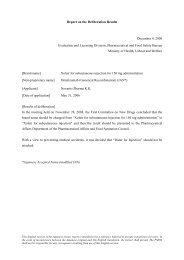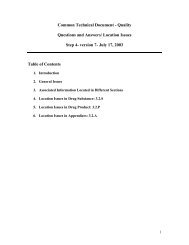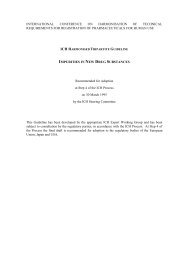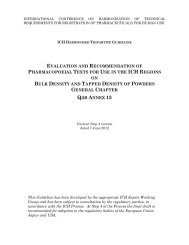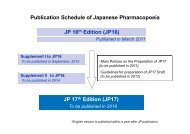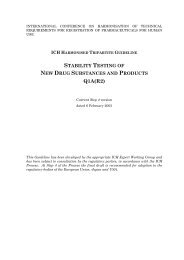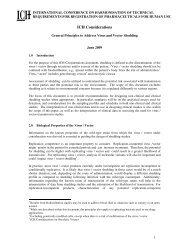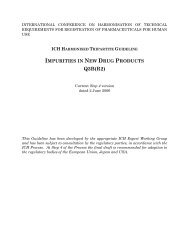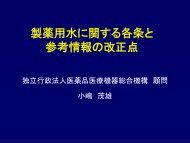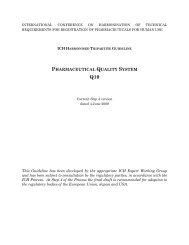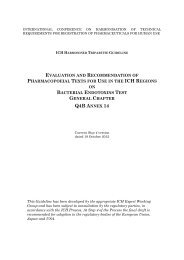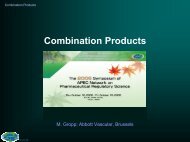4.05 Microbiological Examination of Non-sterile Products
4.05 Microbiological Examination of Non-sterile Products
4.05 Microbiological Examination of Non-sterile Products
- No tags were found...
You also want an ePaper? Increase the reach of your titles
YUMPU automatically turns print PDFs into web optimized ePapers that Google loves.
Incubate at 30 – 35°C for 18 – 24 hours.4-4-2 Selection and subcultureSubculture on a plate <strong>of</strong> cetrimide agar and incubate at 30 – 35°C for 18 – 72 hours.4-4-3 InterpretationGrowth <strong>of</strong> colonies indicates the possible presence <strong>of</strong> P. aeruginosa. This is confirmed byidentification tests.The product complies with the test if colonies are not present or if the confirmatoryidentification tests are negative.4-5 Staphylococcus aureus4-5-1 Sample preparation and pre-incubationPrepare a sample using a 1 in 10 dilution <strong>of</strong> not less than 1 g <strong>of</strong> the product to be examinedas described in Microbial enumeration tests and use 10 mL or the quantity corresponding to 1g or 1 mL to inoculate a suitable amount (determined as described under 3-4) <strong>of</strong> casein soyabean digest broth and homogenise. When testing transdermal patches, filter the volume <strong>of</strong>sample corresponding to 1 patch <strong>of</strong> the preparation described in Microbial enumeration tests(4-5-1) through a <strong>sterile</strong> filter membrane and place in 100 mL <strong>of</strong> casein soya bean digest broth.Incubate at 30 – 35°C for 18 – 24 hours.4-5-2 Selection and subcultureSubculture on a plate <strong>of</strong> mannitol salt agar and incubate at 30 – 35°C for 18 – 72 hours.4-5-3 InterpretationThe possible presence <strong>of</strong> S. aureus is indicated by the growth <strong>of</strong> yellow/white coloniessurrounded by a yellow zone. This is confirmed by identification tests.The product complies with the test if colonies <strong>of</strong> the types described are not present or if theconfirmatory identification tests are negative.4-6 Clostridia4-6-1 Sample preparation and heat treatmentPrepare a sample using a 1 in 10 dilution (with a minimum total volume <strong>of</strong> 20 mL) <strong>of</strong> notless than 2 g or 2 mL <strong>of</strong> the product to be examined as described in Microbial enumerationtests.Divide the sample into two portions <strong>of</strong> at least 10 mL. Heat 1 portion at 80°C for 10 min andcool rapidly. Do not heat the other portion.4-6-2 Selection and subcultureUse 10 mL or the quantity corresponding to 1 g or 1 mL <strong>of</strong> the product to be examined <strong>of</strong>both portions to inoculate suitable amounts (determined as described under 3-4) <strong>of</strong> Reinforcedclostridium medium. Incubate under anaerobic conditions at 30 – 35°C for 48 hours. Afterincubation, make subcultures from each container on Columbia agar and incubate underanaerobic conditions at 30 – 35°C for 48 – 72 hours.4-6-3 InterpretationThe occurrence <strong>of</strong> anaerobic growth <strong>of</strong> rods (with or without endospores) giving a negativecatalase reaction indicates the presence <strong>of</strong> Clostridia. This is confirmed by identification tests.The product compiles with the test if colonies <strong>of</strong> the types described are not present or if theconfirmatory identification tests are negative.4-7 Candida albicans4-7-1 Sample preparation and pre-incubationPrepare the product to be examined as described in Microbial enumeration tests and use 10mL or the quantity corresponding to not less than 1 g or 1 mL to inoculate 100 mL <strong>of</strong>Sabouraud-dextrose broth and mix. Incubate at 30 – 35°C for 3-5 days.4-7-2 Selection and subcultureSubculture on a plate <strong>of</strong> Sabouraud-dextrose agar and incubate at 30 – 35°C for 24 – 4812/29



